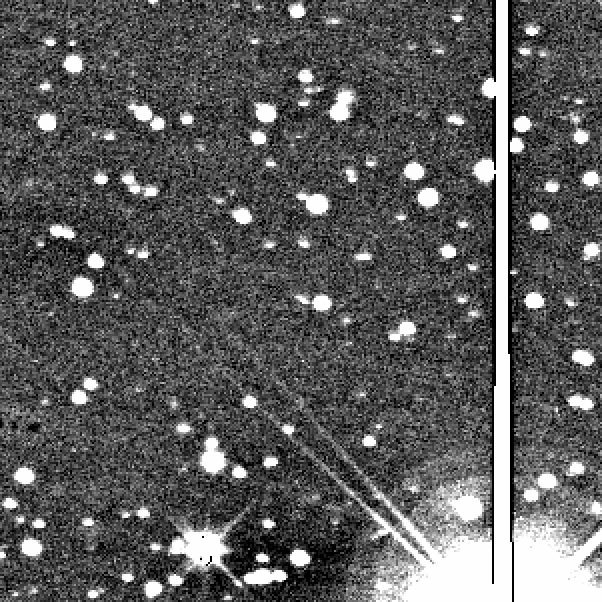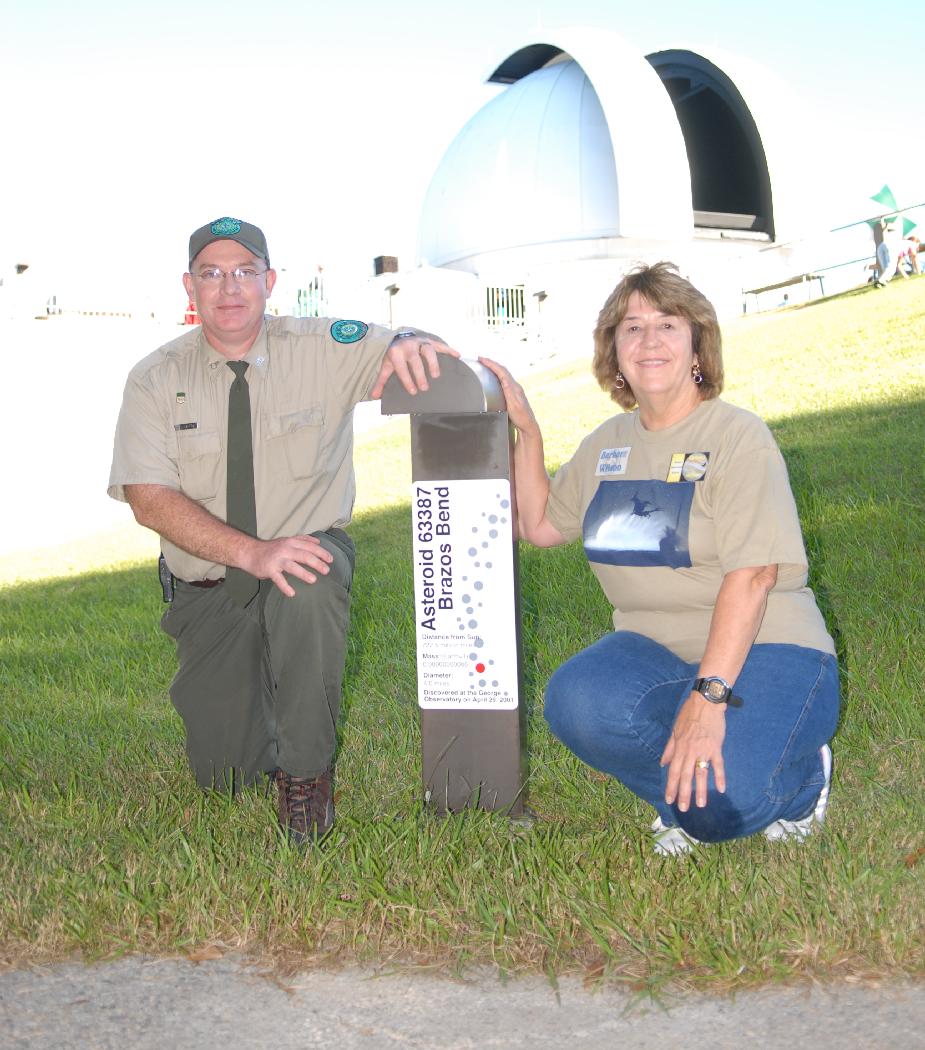
In the sky: An image of asteroid (63387) Brazos Bend, taken in January 2007. This stack represents 24 minutes of time. Brazos Bend is the short diagonal streak at the center of the image, just to the left of a star.
(63387) Brazos Bend = 2001 HC67
Discovered 2001 Apr. 29 at Needville.
Brazos Bend State Park is located on 4975 acres in Fort Bend County,
Texas. One of America's top ten state parks, it is rich in wildlife, including
the American alligator. The park is also home to the George Observatory, where
this minor planet was discovered.

On the ground: At Astronomy Day 2007, the observatory unveiled a plaque for asteroid (63387) Brazos Bend as an addition to their miniature solar-system walk. Left: Park manager Steve Killian, Right: Observatory director Barbara Wilson.
This was one of the most memorable asteroids I ever helped discover. In April 2001 we had only had our new Zhilka-grant AP8P camera a few months. This camera had a field of view 16 times larger than our "Cookbook" camera that had been the team's mainstay for several years. We were still figuring out how to best use it.
Oil is a big part of Houston's economy, and a lot of the people in our astronomy club have jobs in that industry. My day job was creating algorithms for processing exploration-seismic data. Not surprisingly, I was dissatisfied by the astronomical image-processing software then available. So in my spare time, I had begun working on creating my own software for taking the raw images from our camera and converting those into a handful of clean images suitable for astrometry.
In April 2001 I had just reached the point where I thought my software was probably good enough to start using for real, but I needed to verify that. So for a test dataset, on April 1 I shot a long sequence of exposures on an asteroid called ``Vera''. On April 26 we decided to shoot that same star field again. This time around, there was an unknown asteroid in the data! Unfortunately, it was near a star and we couldn't easily do astrometry on it. So we shot it again the following Saturday night:
From joe Sun Apr 29 17:07:44 2001
Subject: Saturday night report
A rather busy night... about 250 folks showed up to look through
the E-dome. We got the last of them out about 10:20PM. I had been cooling
the camera during the last part of the public night (obviously, with it
not attached to the scope).
Max showed up hoping to get the night to do Herschels but since I
had been the person signed up for the night... we did asteroids, and Max
graciously stayed the whole night and did asteroids too. (And, we mean
the WHOLE NIGHT....)
We got it on the 29th, and eventually were able to get usable data from
our observations on the 26th. But the two nights didn't quite link, so
no discovery. The solution? Keep taking data!
Unfortunately, while we had learned how to take lots of images with our
new camera, our capability to process the resulting deluge of data was
lagging behind:
From bill Fri May 18 10:52:15 2001 AIP4WIN and PinPoint are a big help, but they can't do it all. I think a large portion of our potential discoveries will be in objects these astrometric vacuum cleaners can't do. We'll need more people able to use Astrometrica to process these difficult objects in a reasonable amount of time. We're still learning to cope with the data flood this camera can generate. From just two night's worth of data, we detected something like 35 moving objects.
We were also still learning how to best make use of our sometimes-cranky equipment. The traditional astronomer's way to acquire data was to shoot a few long exposures, but sometimes that wouldn't work, if our telescope got in a bad mood:
From joe Sun Apr 29 17:07:44 2001
Unfortunately, the tracking didn't cooperate at all. After shooting
useless image after useless image on our second set on FL6, we decided to
give up and see if the telescope would do any better on EV19. Again, it worked
for a bit right after we got there, then the tracking fell apart again.
Another challenge was the unusual environment of our observatory. Our camera was designed with cool, dry mountaintops in mind, not a hot, humid, coastal swamp:
From joe Thu May 24 11:36:22 2001
Heeding Len and Alex's advice from the night before, we ran the
camera for more than an hour before cooling. It didn't work... a frost ring
rapidly developed about 10 minutes after we started shooting at -20C.
I was shooting a field trying to recover asteroids we saw on both
April 26 and 29 which the MPC failed to link, but which I was pretty sure
linked, on the assumption that they were the same object. I shifted the
field of view to keep the predicted position in the clear area between
the ring and the right edge, and waited for Bill and Don to arrive to confer
on what to do. (This strategy appears to have worked; I think we got it.)
We followed Len's advice and warmed the camera back up, but just
continued shooting (why not?). (Above about -8C or so the camera becomes
pretty useless for real work, if you're curious.) The ring went away, and
then we went back cold, and shifted to Bill's targets.
And, of course, we were too close to a major city to have a very dark sky.
As in most scientific endeavors, the key to success is to persevere, try to work around problems, hypothesize about what the data is trying to tell you, keep good records so you can figure out what works and what doesn't, and not get frustrated! We got another unknown in the May 24 data, but again, it didn't link.
From bill Fri May 25 21:28:56 2001
Basically, it would appear that F15241 is a new object that happened to
be where F14265/F14291 was expected to be. Note too that the brightness
of F14265 and F15241 are about the same -- would we expect that a month
apart? Furthermore, the one brightness estimate we have for F14291 is
two magnitudes below the other two nights.
I can see why we didn't get a designation! Let's go after F15241 as if
it were new. Surely four nights will settle the matter!
From joe Fri May 25 21:35:53 2001
Subject: Re: Is F15241=F14291=F14265?
Yup! I sure hope we manage to get another data point before bright
moon closes in! This endless chasing after asteroids that refuse to link up
is beginning to get annoying!
And of course, we always had to be careful of the usual late-night hazards:
From bill Thu May 24 11:02:21 2001 We had a mini-FBAC meeting with the K2, Frank, Alex, and Wes on 762, which was closed both ways due to an auto wreck at the bend in the road near Brazos Lakes subdivision. I also encountered deer a half-mile north of George ranch for the first time during my drive in. A memorable journey to and from the park last night!
And so we kept trying...
From bill Tue Jun 5 23:59:10 2001
We got another one. In the MPC's monthly report, our F14291 is now 2001
HC67. This is our 62nd discovery, 14th for the year, 24th with the
Zilkha camera. Joe, Max, and I are the co-discoverers.
As hard as we tried, I don't think we ever got a 2nd night on this
object. Joe thought at one point that F14265, F14291, and F15241 were
all the same object, but an orbital fit showed that at least F15241
didn't belong. The arc for this object is 18 days, with 12
observations. The arc starts April 29th, ruling out the tie to F14265,
and it ends May 17th. All these observations may have been
one-nighters, with ours being the earliest, so we captured the
designation.
The nice thing about science is that if you can get enough data, the truth will eventually be revealed. Part of the reason Bill had doubted my proposed linkage was that the resulting orbital fit implied we were discovering an inner-belt asteroid with a rather eccentric orbit at a particularly distant opposition, when it was at its dimmest. Not very likely!!! But, in fact, that's exactly what we had done. My hunch had been correct. Once we got a sufficient orbital arc, it was clear that all those different observations were indeed all of the same object! Here is an orbital diagram for Brazos Bend. At a good opposition Brazos Bend can get as bright as 16th magnitude, which puts it among the two or three brightest asteroids I have participated in discovering.
We also learned to take shorter exposures, and as I kept improving my own software for processing and stacking the resulting large number of images, it became clear that we could go a lot deeper by shooting and processing that way. In other words, we learned to process the data like oil-industry geophysicists!
From joe Wed Jun 6 13:36:40 2001 Looks like the shift-stacking really helped pull the asteroids above the noise in Alex's data. He had seen 3 asteroids by blinking; I've definitely got at least 9 from the same data after processing.
And one of the 6 bonus objects was... 2001 HC67, Brazos Bend, Alex's target.
From bill Wed Jun 6 14:14:08 2001 It's basically the power of stacking. It works in seismic; it works in image processing. This is a real advantage for us. Not only do we have a wide field and a sensitive camera, but your program permits us to go deeper than our drive-limited single exposures would permit. The only disadvantage is that we discover some stuff so faint that only we can follow it up!
Not long after that, everyone on the team switched to using my software to process the data. By the end of 2001 we had developed and evolved almost all of the techniques that we are still using today. This asteroid holds a special place in my heart as the very first one that we were able to ``save'' by using the power of geophysical-style data processing!
Without the cooperation of Brazos Bend State Park, we never would have been able to enjoy this hobby. And so, we dedicate this special asteroid to the park that has made our hobby possible.